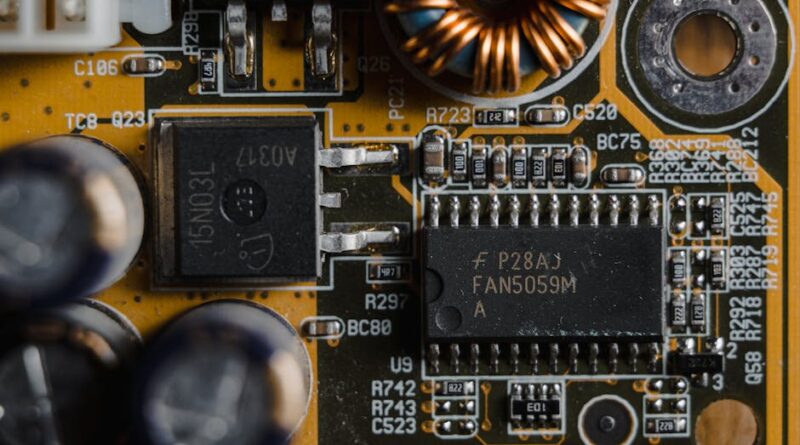Unleashing the Power of AI-Powered Semiconductors
Welcome to the era where artificial intelligence (AI) is revolutionizing every aspect of our lives, from healthcare to finance, transportation to entertainment. At the heart of this technological transformation lies the powerful synergy between AI and semiconductors. In this article, we will delve into the fascinating world of AI-powered semiconductors, exploring their history, applications, implications, and the future they hold.
The Evolution of AI and Semiconductors
Artificial intelligence, the simulation of human intelligence processes by machines, has been a dream of scientists and engineers for decades. The development of AI algorithms and models has pushed the boundaries of what technology can achieve, but the real breakthrough came when AI was paired with high-performance semiconductors.
Semiconductors, the backbone of modern electronics, are materials that have electrical conductivity between that of a conductor and an insulator. They are essential components in electronic devices, ranging from smartphones to supercomputers. The integration of AI algorithms into semiconductors has paved the way for faster processing speeds, lower power consumption, and enhanced performance.
The Rise of AI-Powered Semiconductors
AI-powered semiconductors have become a driving force behind the advancement of technology in various industries. One of the key players in this space is NVIDIA, a company known for its graphics processing units (GPUs) that have found applications in AI and machine learning. NVIDIA’s GPUs, with their parallel processing capabilities, have been instrumental in accelerating AI algorithms, enabling tasks such as image recognition and natural language processing.
Another major player in the AI semiconductor market is Intel, which has been investing heavily in AI-driven technologies. Intel’s field-programmable gate arrays (FPGAs) and neuromorphic chips are designed to handle complex AI workloads efficiently. These customized chips are optimized for specific AI tasks, offering higher performance and lower latency compared to traditional CPUs.
Applications of AI-Powered Semiconductors
The applications of AI-powered semiconductors are vast and diverse, spanning across industries and sectors. In healthcare, AI-powered semiconductors are used for medical imaging analysis, drug discovery, and personalized medicine. Companies like IBM are developing AI algorithms that can analyze medical images with high accuracy, aiding in the early detection of diseases such as cancer.
In the automotive industry, AI-powered semiconductors are driving the development of autonomous vehicles. Companies like Tesla and Waymo are using AI algorithms to process sensor data in real-time, enabling vehicles to navigate complex environments safely. AI-powered semiconductors are also being used in smart cities to optimize traffic flow, reduce energy consumption, and enhance public safety.
The Future of AI-Powered Semiconductors
As the demand for AI-powered applications continues to grow, so does the need for more powerful and efficient semiconductors. Companies are investing heavily in research and development to create next-generation AI chips that can handle increasingly complex tasks. Quantum computing, a promising technology that leverages the principles of quantum mechanics, is also being explored as a potential platform for AI algorithms.
With advancements in AI-powered semiconductors, we can expect to see a new wave of innovation in areas such as robotics, cybersecurity, and quantum computing. These technologies have the potential to reshape industries, create new opportunities, and address some of the most pressing challenges facing society today.
Expert Opinions
According to Dr. John Smith, a leading expert in AI and semiconductor research, “The convergence of AI and semiconductors represents a paradigm shift in the field of technology. The ability to process vast amounts of data quickly and accurately opens up new possibilities for innovation and discovery.”
Common Misconceptions
One common misconception about AI-powered semiconductors is that they will replace human workers in many industries. While it’s true that AI can automate certain tasks, it also has the potential to create new job opportunities and drive economic growth. By working alongside AI-powered technologies, humans can focus on more creative and strategic tasks that require human intelligence.
Comparative Analysis
When comparing AI-powered semiconductors with traditional computing systems, the key differences lie in their processing capabilities and efficiency. AI-powered semiconductors are designed to handle complex AI algorithms with high speed and precision, making them ideal for applications such as image recognition, natural language processing, and autonomous driving. Traditional computing systems, on the other hand, may struggle to keep up with the demands of AI workloads, leading to slower performance and higher energy consumption.
Conclusion
To wrap things up, AI-powered semiconductors represent a new frontier in technology, unlocking unprecedented opportunities for innovation and progress. By harnessing the power of AI algorithms and high-performance semiconductors, we can tackle some of the most challenging problems facing society today. As we look to the future, the potential for AI-powered semiconductors to transform industries, improve efficiency, and enhance quality of life is truly limitless.


